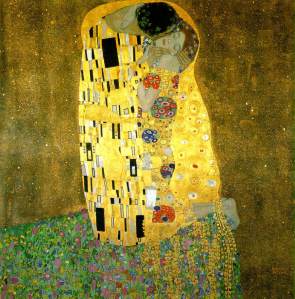The kiss | Gustav Klimt | 1908
Gustav Klimt was the founder of a group of artists called the Viennese Secession, who distanced themselves from the official Austrian academy, of classical tendency, to spread the work of new artists by publishing a magazine.
By the early twentieth century, the art scene was dominated by art nouveau, a movement that sought a young, free art, without the influence of academicism, with its own particular characteristics. The artists found their inspiration in the forms of nature, in its asymmetry and patterns.
At this time, Klimt returned from a trip to Venice and Ravenna, where he had the chance to see Byzantine mosaics, many of which were crafted with gold leaves. Influenced by his father’s trade, a metal engraver, he began experimenting with gold leaves in his own paintings. In this metal, he found an ideal medium for his own purposes: to develop a painting both voluptuous and sensual but at the same time, sober and elegant. And so began what is now called his Golden Phase, where he produced his best known works such as Portrait of Adele Bloch-Bauer, Judith I and, of course, The kiss.
In this work we see a lot of textures resulting from the combination of oil paint and gold leaves. There are three clearly defined areas in the painting: the dark background, the floral pattern at the bottom and finally, the characters.
In The kiss, a man hugs his partner, who is kneeling on a blanket of flowers; while kissing her gently on her left cheek. Although it is said that Klimt was obsessed with sex, the painting shows a tender, innocent kiss.
The bright patterns that cover the characters are ambiguous. It is not known if they are wearing clothes, or if they are covered by blankets. In any case, Klimt did not seem to care much about fashion, as he used to wear a strange robe and sandals when he was in his house (see photo). But one thing that is clear is that these patterns are purely symbolic: in the man, shapes are square or rectangular, linear, referring to masculinity; in the woman, on the contrary, the shapes are round and colorful, therefore referring to femininity. Thus, the characters complement each other asymmetrically.


This is an exquisite painting. Thanks for your commentary.
“Exquisite” sounds just about right, William. Thank you for reading, as always!
We love your work!
Thank you!
Happy birthday, Mr Klimt.
You know? I didn’t have a clue that Klimt’s birthday was the next day I published the post on him!!! Such a coincidence…
[…] couple of months ago I wrote a post about Klimt, in which I introduced the artist and, therefore, is not necessary to do it again […]
Judith I | Gustav Klimt | 1901 « ::: silver and exact ::: said this on January 11, 2013 at 15:13 |
The kiss is one of my most favorites! http://www.segmation.wordpress.com